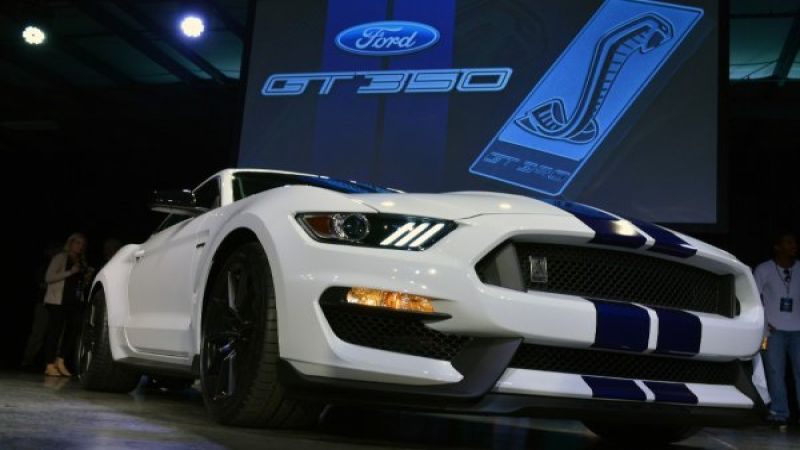The Ford Shelby GT350 Mustang will very likely be the most track capable Mustang ever and a big part of that success will be the new 5.2L V8 engine. This is the biggest engine in the next generation Mustang lineup, but it is much smaller than the high end engine options found in the likes of the Chevrolet Camaro or Dodge Challenger. However, Ford has been touting the flat plane design of this new 5.2L V8 and while everyone has talked about this design, it has become apparent that some readers don’t understand what makes the flat plane 5.2L V8 different than the 5.0L V8 in the Mustang GT.
Today, I will run through the key differences between the 5.0L V8 with a cross plane design from the Mustang GT and the new 5.2L flat plane engine in the Shelby GT350.
Cross Plane 5.0L V8 Explained
The odds are good that if you have seen the crankshaft from a modern Ford Mustang, you have noticed that it is a very large component, with massive counterweights extending away from the areas where the connector rods attach. This cross plane design is used in every production V8 sold in America today and the reason for this design being so popular is that a cross plane V8 offers a great deal smoother action. The huge counterweights on the crankshaft minimize the primary vibration of the engine while the basic cross plane design – with every cylinder in varying stages of the combustion process – minimizes secondary vibration. This prevents you from feeling the internal engine movement when you are in your car or truck and with so much attention paid to “NVH” (Noise, Vibration and Harshness) levels in new vehicles, the cross plane design is ideal.
2015 Ford Mustang Galleries:
The 2015 Ford Mustang Roush RS2
Live images from the 2015 Ford Mustang Detroit Debut
A look at the similarities in styling across the 2015 Ford Mustang trimlines
The 2015 Ford Mustang in Triple Yellow
The disadvantage to the cross plane V8 design in the 2015 Ford Mustang GT (and every other V8 car and truck in America) is that, while smooth, that counterweight design adds a great deal of rotation mass to the crankshaft. That addition mass actually eats up some power, as the engine has to work harder simply to turn the internal components and that extra effort needed increases the time it takes for the engine to build RPM. The quicker you can build RPM, the quicker you can reach your peak power outputs so compared to a flat plane design, the cross plane 5.0L V8 revs slower and makes a touch less power due to the design of the crankshaft.
Flat Plane 5.2L V8 Explained
The new 5.2L Shelby GT350 Mustang engine uses a flat plane V8 design that has previously been reserved for race cars and very high end exotics. Unlike the cross plane, the flat plane engine doesn’t have the huge counterweights around each connecting rod and that should allow the 5.2L V8 to make more power (since less effort is required to spin the crankshaft) and rev much more quickly, thus allowing you to get into the power band more quickly. The downside to the flat plane design is that the lack of counterweights usually causes increased engine vibration. The design of the flat plane V8 actually minimizes primary vibration on its own, which is why the counterweights are not needed. However, the flat plane V8 design does not have a built in measure to fight secondary balance, so this style of engine generally has more internal vibration.
The reason that flat plane V8s have typically been reserved for race cars and high end exotics, is that race car drivers don’t care about some additional vibration and high end companies like Ferrari can use ultra-lightweight materials to reduce the vibration of the engine. When you are selling a car for $250,000, you can afford to use cutting edge technology to engineer your connecting rods and pistons, but that is a little more of a challenge for affordable cars.
One other advantage of most flat plane V8 engines is that they have a shorter stroke, thus needing less crankcase space. Should this be the case with the new 5.2L Shelby GT350 Mustang engine, the Ford engineers could sit the engine lower to the ground and that would help to reduce weight and lower the car’s center of gravity.
The biggest downside to this design is reduced torque levels through the short engine stroke and with promised figures of at least 500hp and 400lb-ft of torque, the new GT350 does have a lower torque level than expected.
Pros and Cons for the Shelby GT350
The Ford Shelby GT350 Mustang will benefit in a variety of ways from the use of the new 5.2L flat plane V8 and while I have addressed these points above, I thought that it would be good to close by summing it all up.
Pros:
-First and foremost, the flat plane crank weighs less, so the Shelby GT350 Mustang engine will be more efficient in getting its power to the wheels.
-This lightweight crank will allow the 5.2L engine to reach its peak power more quickly while also having a much broader peak power band, which is ideal for road racing.
-The engine will be lighter, thus lowering the overall weight of the new GT350 Mustang and with that weight coming off of the front end, Ford should be able to obtain a better front to rear weight distribution.
-The engine could be smaller, which would allow Ford to position it lower in the engine bay and that would improve handling.
Cons:
-The flat plane V8 engine typically has more engine vibration, but use of high end materials should eliminate much of that. Also, the GT350 should be awesome enough that drivers won’t be worrying about a touch of engine vibration.
-Low torque levels.
-The flat plane design generally costs more to create for a road car, but if the new Ford Shelby GT350 Mustang does prove to be the most track capable Mustang ever – the advantages should be worth the added cost.
Ford has been fairly tight lipped thus far about the new Shelby GT350 Mustang and the flat plane 5.2L V8, but I expect to see a flood of information on this new super-Stang over the next few months. Click here for a detailed look at features that make the new Shelby GT350 the most track capable Mustang ever.













Comments
You didn't mention firing
Permalink
You didn't mention firing order and exhaust note.
I can't see how there'd be
Permalink
I can't see how there'd be that much of a difference other than engine block length between a flat 8 versus a Subaru boxer 6. What would be the difference between this Ford engine and Subaru slapping two of their boxer 4 engines together? And as for engine vibration, Subaru's have nearly none.
Or are they not making it a horizontally opposed engine?
its not horizontal its a v8
Permalink
In reply to I can't see how there'd be by Carl (not verified)
its not horizontal its a v8
the crank is just different
No, it's not a horizontally
Permalink
In reply to I can't see how there'd be by Carl (not verified)
No, it's not a horizontally opposed engine. It's a 90 degree V8 with a flatplane Crankshaft as opposed to a crossplane Crankshaft. The reason why the GT 350 engine may sit lower in the engine bay is because Flatplane crankshafts don't have heavy counterweights on them which while rotating take up vertical space..
Horizontally opposed engines are great and very smooth. But I believe it would be difficult to mount a 5.2 liter Boxer 8 in a front engine car. It would be both very long and very wide and most likely interfere with steering and suspension and other components.
Most large boxer engines now and in the past have been mid or rear engined. Aka Porsche.
You are correct that a boxer
Permalink
In reply to No, it's not a horizontally by frank bollo (not verified)
You are correct that a boxer eight is too wide for its length. It's not very long, it's more compact than inline or vee, it is super smooth and offers lowest center of gravity in all design. Its problem is width and exhaust ports. It is difficult to package at 8 cylinders and I've yet to see a major manufacturer put one in modern production.
Ford has a long history of
Permalink
Ford has a long history of building flat plane V-8's for Formula 1. When the Ford-Cosworth DFV (double four valve) came on the scene in the late 1960's, it became the engine for a team to run and win. I think they were still winning world championship events with this engine all the way into the early 1980's in Formula and other racing platforms like sports racing.
Flat plane V-8's sound exactly the way you expect a real racing engine to sound. An old Ferrari 308 QV with a track exhaust sounds great. I can't wait to hear audio of this engine when somebody puts it on the web.
The cost comment on the
Permalink
The cost comment on the engine seems a bit off. A flat plane crankshaft, in production numbers, will cost less to produce than a splayed/cross-plane crank as it is a simpler piece. The differences in the camshafts will be negligible. The rest of the parts are on par, although the pistons and rods will need to be lighter. The actual production cost for the entire assembly might not be much more at all, if any, than the standard Coyote.
I've seen a picture of the
Permalink
I've seen a picture of the new crankshaft and it seems wholly unconventional- Typical flat plane V8 crankshafts look like Inline-4 crankshafts with wider crank pins, that is to say, pins 2 and 3 are at the same angle, and pins 1 and 4 are at the same angle. Thus, the outer pistons move together and the inner pistons move together, eliminating any rocking motions along the axis transverse to the engine. The crankshaft I've seen for the GT 350 however shows pins 1 and 3 at the same angle and 2 and 4 at the same angle, which would create a rocking motion in each cylinder bank. Anybody know what's going on here?
I'm way late commenting on
Permalink
I'm way late commenting on this, but this flat plane V-8 gives me concerns. First the best way to eat up main bearings is to unbalance the crankshaft. This design is going to sound exactly like two inline 4-cylinder engines sharing the same exhaust. The claim of quicker revving ability may be true for first gear only, where the engine revs up so quickly. It would not be noticed in higher gears. I have heard 5.0 Mustangs rev in neutral and they go from idle to redline in less than a second. As for mounting the engine lower to the ground, shaving the counterweight diameter down might allow 1/2 inch. The reason this racing flat plane design is not used in street cars is not exotics or performance.... this crank is cheaper than a cross plane crank. It's to save $$. Ford actually spends great effort shielding this engine's vibrations from the frame and body. Lastly, I heard the stereo system actually plays a standard good-sounding V-8 sound over the speakers when this thing accelerates. I'm blaming this on the new European Ford Brass that have no clue what American drivers want in sports car engines and sound.
Ummm... Wow where do I start
Permalink
In reply to I'm way late commenting on by Doug Waller (not verified)
Ummm... Wow where do I start in disputing the claims here ? Facts stated without foundation..
Let's start with the most ridiculous first. You heard Where ? assuming you're not kidding, There is an audio soundtrack playing V-8 Noises ?? As an owner of a 2016 GT350 I assure you, and everyone reading here This is not true ! perhaps you're confusing Ford with other manufacturers BMW, Audi, Mazda, and others with their various engine noise generators... The sounds this engine, and exhaust make are nothing short of intoxicating, in mine, and many others opinion.
Yeah, Ford has no clue what
Permalink
In reply to I'm way late commenting on by Doug Waller (not verified)
Yeah, Ford has no clue what Americans want in engines, and sound... Brilliant.
That must explain why demand far exceeds supply for the GT-350. Fact is about 1/3 of qualified buyers can't get one. Oh, and the part about the audio soundtrack.. You heard ? Really ? Lol...
We'll leave that to the experts at BMW, Lexus, Audi, Mazda, and others who actually have done that !
drive a new GT 5.0 and a
Permalink
drive a new GT 5.0 and a GT350... they are in the same shape body car, other than that wow, sound, response, handling, etc are both great BUT different... I must admit to making involuntary giggling noises in the GT350. I think it is a shame that the dealers put a premium on what otherwise would be an affordable option to Italian sports cars and on par with high end Corvettes...the performance is amazing and the sound doesn't need any help, it is killer on its own lol...I have had a few Corvettes but would not hesitate to have my car's logo match the one on the trucks I have always owned. In the 60s etc we raced Chevy's (mostly because the parts are cheaper and interchangeable)i.e. Ford had three 351s that all used different parts? (W, C, M) but we pulled our race cars with Ford pick ups! You might find a GT 350 at the honest price as they should be easier to find when the GT500 takes the spotlight...
The cross plane V8 needs big
Permalink
The cross plane V8 needs big balance weights as it produces a rocking couple. The back of the engine goes down as the front rises, 180 degrees later the front drops and the back kicks up.
A flat plane V8 with conventional up, down, down, up crank has perfect primary force and couple balance. It has a secondary force out of balance at 2x engine speed that is 1.4x bigger than a single bank. The only way to balance 2ndry forces is by use of balance shafts a la Porsche 944/968. There are internally balanced couples that bend the crank, these are balanced by balance webs so the crank runs straight. A major problem is that even without the balance webs the engine will run with exactly the same vibration as it does with them. As the couple is internally balanced it is impossible to balance these couples using a dynamic balancing machine, they have to be precisely calculated and adjusted for any change to piston and con rod mass. There is a distinct risk that the aftermarket will produce lightweight cranks that wipe out the main bearings due to crank bending, this would soon give the engine a bad reputation with tuners.
Ford's flat plane crank is unconventional, up, down, up, down, this reduces bending of the crank. It has perfect primary force balance and the same 2ndry balance as conventional flat plane crank. There are 2 unbalanced couples that add to give a large unbalanced couple. The unbalanced couple is about 2/3rds the size of the couple in a cross plane V8. This reduction allows the crank to be fully balanced by internal counterweights at front and rear with neutral balance pulley and flywheel. As the crank produces an external couple it can be balanced for changes to piston and con rod weights on a dynamic balancing machine by any shop that can balance a cross plane crank using exactly the same method.